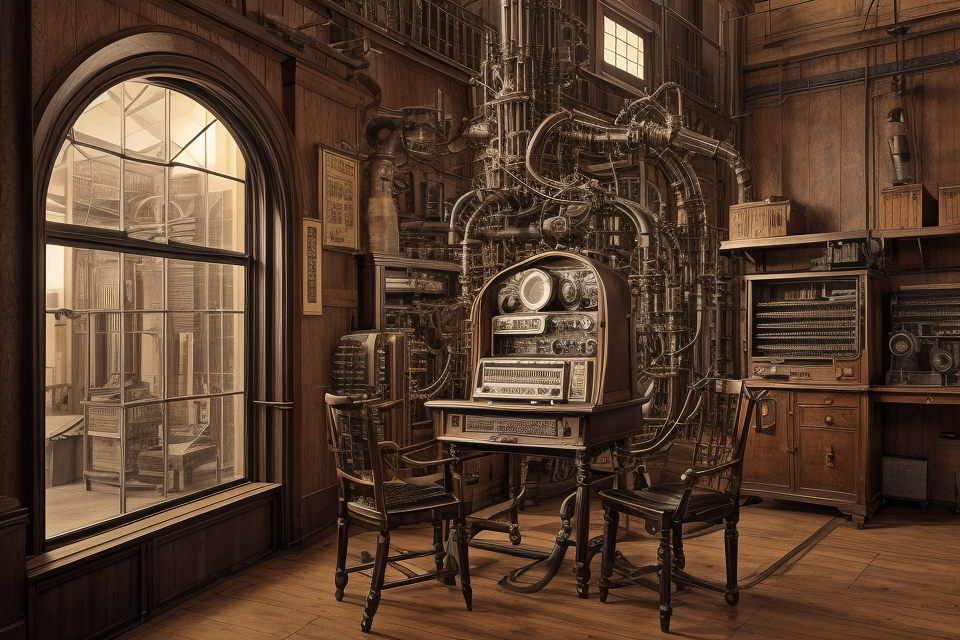The history of computers is a fascinating journey that takes us back to the ancient world. The invention of the first computer is a monumental achievement that has transformed the world beyond recognition. The race to create the first computer was a fierce competition between brilliant minds, each vying for the title of the inventor of the world’s first computer. In this article, we will explore the fascinating history of the world’s first computer and the brilliant minds behind it. From the early mechanical calculators to the first electronic computers, we will uncover the story of how these pioneers of technology changed the world forever. Join us as we delve into the thrilling world of computer history and discover the true inventor of the world’s first computer.
The invention of the first computer in the world is a subject of historical debate, as different individuals and organizations have made significant contributions to the development of computing technology. However, it is widely accepted that the first electronic digital computer was the ENIAC (Electronic Numerical Integrator and Computer), which was developed in the 1940s by a team led by John Mauchly and J. Presper Eckert at the University of Pennsylvania. The ENIAC was a landmark achievement in computing history, as it was the first computer to use electronic components to perform calculations, paving the way for the modern computers we use today. Other notable early computers include the Colossus, developed by British mathematician Tommy Flowers, and the IBM 701, which was developed by IBM in the 1950s. Regardless of who is credited with inventing the first computer, it is clear that the development of computing technology has had a profound impact on society and has revolutionized the way we live, work, and communicate.
Exploring the Origins of the First Computer
The Definition of a Computer
The invention of the first computer in the world was a monumental event in the history of technology. But before delving into the details of who invented it, it is important to define what a computer is.
A computer is an electronic device that is capable of processing and storing data. It is designed to perform a wide range of tasks, from simple calculations to complex operations. The computer is capable of receiving input from various sources, such as a keyboard or a mouse, and then processes this input to produce an output.
The computer has revolutionized the way we live and work. It has enabled us to automate repetitive tasks, communicate with people across the globe, and access vast amounts of information at our fingertips.
The concept of a computer dates back to the 19th century, when mathematicians and engineers first began experimenting with mechanical devices that could perform basic calculations. However, it was not until the 20th century that the modern computer as we know it today began to take shape.
The first computers were massive machines that filled entire rooms and required teams of engineers to operate them. They were used primarily for scientific and military purposes, such as calculating ballistic trajectories and breaking codes.
As technology advanced, computers became smaller, more powerful, and more accessible to the general public. Today, computers are an integral part of our daily lives, and we rely on them for everything from shopping and banking to entertainment and communication.
In the next section, we will explore the origins of the first computer in the world and the people who played a key role in its development.
Early Computing Devices and Precursors to the Modern Computer
In the early 20th century, the development of the first computer was an evolutionary process that involved various inventors and their innovations. While there were several precursors to the modern computer, there are a few key devices that laid the foundation for the electronic computer.
The Analytical Engine
The Analytical Engine, designed by Charles Babbage in the early 1800s, was a mechanical general-purpose computer that could perform any calculation that could be expressed in an algorithm. Babbage’s design was based on the concept of Turing machines, which could be programmed to solve a wide range of mathematical problems.
The Difference Engine
The Difference Engine, also designed by Charles Babbage, was an early mechanical calculator that could perform complex calculations. It was designed to calculate navigation tables for sailing ships, but it was never built.
The Tabulating Machine
The Tabulating Machine, developed by Herman Hollerith in 1890, was an electromechanical device that could process data by punching holes in cards. This machine was used to tabulate the results of the US census and marked the beginning of the era of electronic computing.
The Z1
The Z1, built by Konrad Zuse in 1936, was the world’s first functional programmable computer. It was made entirely of metal and used binary arithmetic. Although it was not the first computer built, it was the first to be demonstrated to be functional.
In conclusion, the early computing devices and precursors to the modern computer played a crucial role in the development of the electronic computer. The contributions of inventors like Charles Babbage, Herman Hollerith, and Konrad Zuse paved the way for the modern computer, which has become an essential part of our daily lives.
The Birth of the First Programmable Computer
Charles Babbage and the Analytical Engine
Charles Babbage, an English mathematician and inventor, is widely recognized as the “father of the computer” for his pioneering work in the development of the first programmable computer. His most significant contribution was the design of the Analytical Engine, a mechanical general-purpose computer that was capable of executing complex calculations and performing a wide range of operations.
Babbage was born in 1791 in London, England, and received his education at Trinity College, Cambridge. He was a polymath who made significant contributions to various fields, including mathematics, science, and technology. In the early 19th century, Babbage became interested in the problem of mathematical calculations and began to explore the possibility of creating a machine that could automate these tasks.
The Analytical Engine was the result of Babbage’s work on this problem. He designed the engine to be a mechanical device that could perform arithmetic and logical operations using punch cards, which were similar to those used in the Jacquard loom. The engine was programmable, meaning that it could be instructed to perform different calculations by changing the sequence of punch cards inserted into the machine.
Babbage’s design for the Analytical Engine was a revolutionary concept that represented a significant departure from earlier mechanical calculators. Unlike these earlier machines, which were designed for specific purposes, the Analytical Engine was a general-purpose computer that could be programmed to perform a wide range of calculations and operations. Babbage’s design included a number of innovative features, such as the use of loops and conditional statements, which would later become standard components of computer programming languages.
Although the Analytical Engine was never built during Babbage’s lifetime, his design was highly influential and inspired later generations of computer scientists and engineers. The concepts and principles he developed for the Analytical Engine laid the foundation for modern computer design and helped to pave the way for the development of the first electronic computers in the mid-20th century.
Today, Babbage is remembered as a visionary and a pioneer in the field of computer science. His work on the Analytical Engine represents a critical milestone in the history of computing and serves as a testament to the power of human ingenuity and creativity.
Ada Lovelace’s Contribution to Computer Programming
Ada Lovelace is often considered to be the first computer programmer in history. Born in 1815, Lovelace was a mathematician and writer who was fascinated by the work of Charles Babbage, an English inventor and mathematician who designed the first mechanical general-purpose computer, the Analytical Engine.
Lovelace was particularly interested in the potential of the Analytical Engine, and she wrote a series of notes and papers on the machine that are considered to be the first computer programs. In her notes, Lovelace explored the capabilities of the Analytical Engine and suggested a number of potential uses for the machine, including the calculation of complex mathematical equations and the composition of music.
Lovelace’s work on the Analytical Engine was groundbreaking, as it demonstrated the potential of computers to be used for a wide range of tasks beyond simple arithmetic. Her work also laid the foundation for the development of modern computer programming languages and techniques, making her a key figure in the history of computing.
Today, Lovelace is recognized as a pioneer in the field of computer science, and her contributions to the development of the Analytical Engine and computer programming are still celebrated and studied by computer scientists and historians around the world.
The First Electronic Computer
The Atanasoff-Berry Computer (ABC)
The Atanasoff-Berry Computer (ABC) was the first electronic computer in the world. It was designed and built by John Vincent Atanasoff and Clifford Berry in the late 1930s. The ABC was an early prototype of the modern computer, and it used vacuum tubes and capacitors to perform calculations.
The ABC was designed to solve systems of linear equations, which was a time-consuming task for humans to perform manually. The machine was capable of performing these calculations much faster than any human could, making it a revolutionary innovation for its time.
The ABC was also designed to be easy to use, with a simple interface that allowed users to input data and receive results. This made it accessible to a wide range of users, including scientists, engineers, and mathematicians.
Despite its innovative design, the ABC was never widely adopted due to the complexity of the technology at the time. However, it laid the groundwork for the development of the modern computer, and its influence can still be seen in the design of computers today.
The Colossus Computer
The Colossus computer was the first electronic computer in the world, and it was built in the late 1940s. It was developed by a team of engineers and mathematicians led by Tommy Flowers, a British engineer. The Colossus was designed to break the German Lorenz code, which was used to communicate high-level military messages during World War II.
The Colossus was a remarkable machine for its time, and it was capable of performing complex mathematical calculations at an incredible speed. It was also the first computer to use valves, which were the predecessors of modern-day transistors. The machine had a weight of around 7 tons and consumed around 5 kilowatts of power.
One of the most significant features of the Colossus was its ability to perform a large number of calculations simultaneously. It had a design that allowed it to perform a number of calculations in parallel, which made it much faster than its mechanical and electro-mechanical predecessors. This feature was essential for the task of code-breaking, which required the machine to perform a large number of calculations quickly.
The Colossus was an incredible achievement for its time, and it laid the foundation for the development of modern computers. It demonstrated the potential of electronic computers and inspired the development of subsequent generations of machines. Although the Colossus was not the first computer ever built, it was the first electronic computer that was capable of performing complex calculations, and it played a crucial role in the outcome of World War II.
The ENIAC (Electronic Numerical Integrator and Computer)
The ENIAC, or Electronic Numerical Integrator and Computer, was the first electronic computer in the world. It was built in the 1940s at the University of Pennsylvania in Philadelphia, Pennsylvania, USA. The ENIAC was designed to perform mathematical calculations for the United States military, specifically for the Ballistic Missile Early Warning System.
The ENIAC was an enormous machine, measuring 16 feet high, 27 feet wide, and 6 feet deep. It weighed almost 27 tons and consumed over 150 kilowatts of power. It had 4,500 electronic vacuum tubes, which were used to perform mathematical calculations. The tubes were arranged in panels, each with a different function, such as addition, subtraction, multiplication, and division.
The ENIAC was capable of performing complex calculations at an unprecedented speed. It could perform 5,000 additions per second, which was much faster than any mechanical calculator at the time. This speed was achieved by using electronic circuits to perform calculations, rather than mechanical parts.
The ENIAC was an enormous breakthrough in the field of computing, and it laid the foundation for the development of modern computers. Its design and construction required a great deal of ingenuity and technical expertise, and it paved the way for the development of more sophisticated electronic computers in the years to come.
The ENIAC was a remarkable achievement, and it represented a significant milestone in the history of computing. Its design and construction demonstrated the potential of electronic computers to revolutionize the way we solve mathematical problems, and it opened up new possibilities for scientific research and technological innovation.
Despite its groundbreaking capabilities, the ENIAC was not without its challenges. It required a large team of skilled technicians to operate and maintain it, and it was prone to malfunctions and breakdowns. Nevertheless, the ENIAC remained an important and influential machine, and it played a crucial role in the development of modern computing.
The First General-Purpose Computer
The Manchester Mark 1
The Manchester Mark 1, also known as the “Baby,” was the world’s first general-purpose computer. It was designed and built by a team of mathematicians and engineers led by Professor Freddie Williams at the University of Manchester in England. The machine was completed in April 1948 and became operational in June of the same year.
The Manchester Mark 1 was a revolutionary machine for its time. It was the first computer to use stored-program concepts, which meant that the machine’s instructions and data could be stored in the same memory. This was a significant breakthrough as it allowed the computer to be programmed to perform a wide range of tasks, making it the first general-purpose computer.
The machine was constructed using a combination of valves (vacuum tubes) and electronic circuits. It had a memory of 32 kilobytes, which was a remarkable achievement considering the first electronic digital computers had only a few hundred bytes of memory. The Manchester Mark 1 also had the ability to perform calculations at a rate of 1.5 million calculations per second, which was an impressive feat for the time.
The Manchester Mark 1 played a crucial role in the development of early computing and set the stage for the next generation of computers. It was used for a variety of applications, including scientific calculations, cryptography, and programming research. The success of the Manchester Mark 1 led to the development of many other computers in the following years, including the famous EDSAC (Electronic Delay Storage Automatic Calculator) at the University of Cambridge.
Overall, the Manchester Mark 1 was a groundbreaking machine that marked the beginning of the modern computer era. Its innovative design and capabilities set the stage for the development of many other computers and played a crucial role in the advancement of computing technology.
The EDSAC (Electronic Delay Storage Automatic Calculator)
The EDSAC (Electronic Delay Storage Automatic Calculator) was an early computer developed at the University of Cambridge in the 1940s. It was designed by a team led by mathematician Maurice Wilkes, and was one of the first computers to use electronic circuits instead of mechanical or electromechanical components.
One of the key features of the EDSAC was its use of “memory” stored in the form of electronic charges on a cathode ray tube. This allowed the computer to store and retrieve data, making it the first general-purpose computer capable of executing a wide range of programs.
The EDSAC was also notable for its use of a high-level programming language, which allowed programmers to write code in a more abstract and human-readable form. This was a significant departure from the low-level assembly language used in earlier computers, and paved the way for the development of modern programming languages.
Despite its pioneering status, the EDSAC was not a commercial success and was eventually dismantled in the early 1950s. However, its influence on the development of computing technology was significant, and it remains an important milestone in the history of computing.
The UNIVAC I (Universal Automatic Computer)
The UNIVAC I, developed by J. Presper Eckert and Mitchell, was the first general-purpose electronic computer. It was commissioned by the United States Census Bureau to process the 1950 United States Census data. The UNIVAC I used 1200 vacuum tubes and weighed around 16 short tons.
Technical Specifications
- Bit capacity: 12-bit
- Memory: 1,000 12-bit words (equivalent to 4,800 characters)
- Processing speed: 120,000 additions per second
- Input/output: Punched card reader and printer
Design and Architecture
The UNIVAC I used a decimal arithmetic system and was based on a central processing unit (CPU) design that combined logic and memory into a single unit. It used a binary-coded decimal (BCD) system for arithmetic operations and had a magnetic drum memory with a capacity of 1,000 12-bit words.
Applications
The UNIVAC I was primarily used for scientific and statistical calculations, including weather forecasting, economic analysis, and military applications. It was also used to process the 1950 United States Census data, which was the first time that data was processed electronically rather than by hand.
Legacy
The UNIVAC I was an important milestone in the history of computing, as it was the first general-purpose electronic computer and set the stage for the development of subsequent computers. Its use of a central processing unit (CPU) design, combined with a magnetic drum memory, became the standard architecture for computers for many years to come.
The Evolution of Computers
The Influence of Early Computers on Modern Technology
Early computers played a crucial role in shaping the modern technology we use today. The invention of the first computer not only revolutionized the field of computing but also had a profound impact on various industries, leading to the development of new technologies and innovations.
One of the significant influences of early computers was on the field of electronics. The development of electronic components and circuitry used in early computers paved the way for the widespread use of electronics in various devices and appliances. The development of transistors, diodes, and other electronic components in the 1940s and 1950s made it possible to build smaller and more efficient electronic devices, including portable radios, televisions, and eventually, personal computers.
Another area heavily influenced by early computers was the field of telecommunications. The use of computers in the development of telecommunication networks allowed for faster and more efficient communication. Early computers were used to develop switching systems for telephone networks, which allowed for multiple calls to be connected through a single line. This led to the development of advanced communication systems, including the Internet, which revolutionized the way people communicate and access information.
Early computers also had a significant impact on the field of medicine. The development of early computers made it possible to store and process large amounts of medical data, including patient records and medical research. This led to the development of advanced medical technologies, including medical imaging, robotic surgery, and precision medicine.
Furthermore, early computers played a crucial role in the development of aerospace technology. Computers were used to design and simulate complex aerospace systems, including aircraft and spacecraft. This led to the development of advanced aerospace technologies, including satellite navigation, remote sensing, and space exploration.
In conclusion, the influence of early computers on modern technology cannot be overstated. The development of early computers led to the development of numerous technologies and innovations, including electronics, telecommunications, medicine, and aerospace. These technologies have transformed the world and continue to shape the future of human progress.
Advancements in Computer Architecture and Design
As technology progressed, computer architecture and design underwent significant advancements. The earliest computers were massive, complex, and expensive machines that could only perform a limited range of tasks. However, as time passed, engineers and inventors made improvements to the design and architecture of computers, leading to smaller, more efficient, and versatile machines.
One of the key advancements in computer architecture was the development of the stored-program concept. This concept involved storing both the data and the instructions for processing that data in the same memory. This breakthrough allowed for greater flexibility in programming and enabled computers to perform a wider range of tasks.
Another important development was the creation of the microprocessor. The microprocessor integrated the central processing unit (CPU), memory, and input/output (I/O) functions onto a single chip, making computers smaller, faster, and more affordable. This innovation led to the widespread adoption of personal computers and the development of new technologies such as the internet.
In addition to these technological advancements, computer architecture and design also evolved to address issues related to security and reliability. As computers became more ubiquitous, it became increasingly important to protect against unauthorized access and to ensure that systems remained operational in the face of potential threats. This led to the development of new security measures and redundancy systems, which helped to make computers more secure and reliable.
Overall, the advancements in computer architecture and design played a crucial role in the evolution of computers. By making machines smaller, faster, and more versatile, these developments helped to drive the widespread adoption of computers and paved the way for the creation of new technologies that have transformed the world.
FAQs
1. Who invented the first computer in the world?
The first computer in the world was invented by a team of researchers led by Konrad Zuse in 1936. Zuse was a German engineer and mathematician who is credited with creating the first functional programmable computer. His invention, known as the Z1, was an electro-mechanical computer that used punch cards to store data and perform calculations. The Z1 was a revolutionary machine for its time and marked the beginning of the modern computer era.
2. What was the first computer called?
The first computer was called the Z1 and was invented by Konrad Zuse in 1936. It was an electro-mechanical computer that used punch cards to store data and perform calculations. The Z1 was a revolutionary machine for its time and marked the beginning of the modern computer era. It was capable of performing complex mathematical calculations and was the first computer to use a binary system for storing and processing data.
3. When was the first computer invented?
The first computer in the world was invented in 1936 by a team of researchers led by Konrad Zuse. The computer, known as the Z1, was an electro-mechanical computer that used punch cards to store data and perform calculations. It was a revolutionary machine for its time and marked the beginning of the modern computer era.
4. Who was Konrad Zuse?
Konrad Zuse was a German engineer and mathematician who is credited with creating the first functional programmable computer. He led a team of researchers who invented the first computer in the world, known as the Z1, in 1936. Zuse was a pioneer in the field of computer science and his invention marked the beginning of the modern computer era.
5. Where was the first computer invented?
The first computer in the world was invented by a team of researchers led by Konrad Zuse in Germany in 1936. The computer, known as the Z1, was an electro-mechanical computer that used punch cards to store data and perform calculations. It was a revolutionary machine for its time and marked the beginning of the modern computer era.



